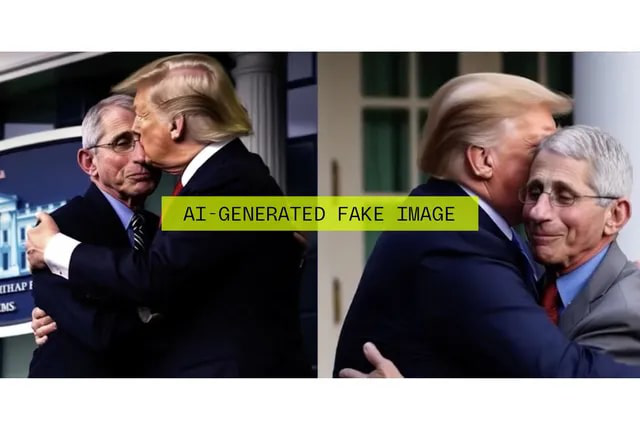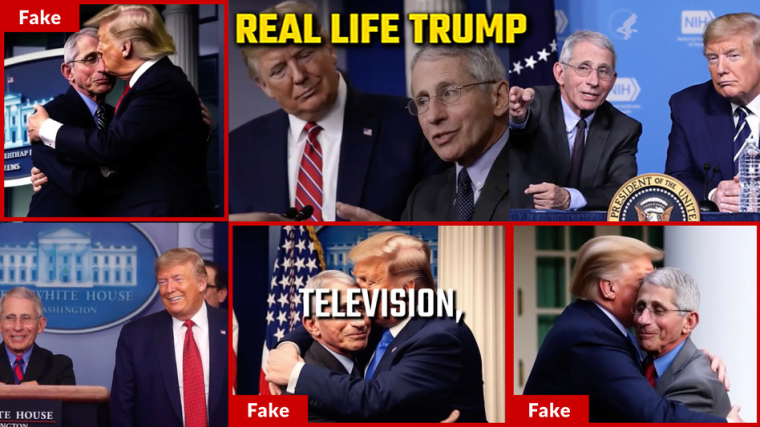
Ron DeSantis, the Governor of Florida, recently shared a campaign video that aimed to criticize Donald Trump.
The video displayed three photos of the former president embracing Anthony Fauci, a prominent US coronavirus task force member, and kissing him on the cheek.
However, three media forensics experts interviewed by AFP suggest that these images may have been digitally manipulated using artificial intelligence technology.
The DeSantis AI Trump Ad Controversy
Political advertising has always been a powerful tool for candidates to shape public opinion and influence voters.
In a highly controversial move, a recent political advertisement by Florida Governor Ron DeSantis has come under scrutiny for its use of manipulated images created using artificial intelligence (AI) technology.
The ad depicts former President Donald Trump engaging in friendly physical gestures with Dr. Anthony Fauci, the renowned immunologist, and former White House Coronavirus Task Force member.
In a tweet posted on June 5, 2023, the DeSantis rapid response team wrote, “Donald Trump gained fame by terminating numerous individuals on television. But when it came to Fauci…”
Donald Trump became a household name by FIRING countless people *on television*
But when it came to Fauci… pic.twitter.com/7Lxwf75NQm
— DeSantis War Room 🐊 (@DeSantisWarRoom) June 5, 2023
The 44-second video features a contrast between footage of Trump saying, “You’re fired” during his time as a reality TV show host.
It also includes his explanations for not removing Fauci, who served as the head of the US National Institute of Allergy and Infectious Diseases and was a prominent figure in America’s COVID-19 response.
While Trump is heard in the DeSantis ad likening firing Fauci to dropping a “bomb,” the screen displays a collage of six pictures featuring Trump and Fauci.
Last year, Dr. Fauci, who assumed the role of White House chief medical advisor during President Joe Biden’s administration, concluded his career in public service.
Although Fauci received praise for his efforts during the pandemic, he also faced criticism from those spreading COVID-19 misinformation.
Some conservatives in the United States directed their anger toward him for his early advocacy for social distancing and other public health measures to slow the spread of COVID-19.
Expert Analysis and Unmasking the Deepfake
While political campaigns have long employed various tactics to sway public opinion, AI-generated images blur the line between truth and fabrication.
The video shared by the “DeSantis War Room” Twitter account was seemingly established by the DeSantis campaign last year.
🚨 Introducing @DeSantisWarRoom: Follow us for rapid response to dishonest attacks from legacy media and Democrat politicians (but I repeat myself)! https://t.co/7Pnd25R9Gh
— Christina Pushaw 🐊 🇺🇸 (@ChristinaPushaw) August 24, 2022
The account was introduced by Christina Pushaw, who previously served as the press secretary to the Florida governor before moving to a role in his campaign in August 2022.
However, upon closer examination, experts specializing in digital forensics and deep fake detection were able to identify the manipulated nature of the images.

They discovered visual artifacts, inconsistencies, and irregularities in the facial features, lighting, and shadows, all of which conclusively proved that the images were created using AI-generated deepfake technology.
Three of the photos, which show the men together in March 2020, are genuine and were taken by photographers from Getty Images, the National Institutes of Health, and Reuters.
However, the remaining pictures, which supposedly depict Trump kissing Fauci’s cheek on three separate occasions, display characteristics typical of AI-generated imagery.
Hany Farid, a Professor at the University of California, Berkeley, who is an expert in digital forensics, image analysis, human perception, and misinformation, has stated that the combination of real and fake images is misleading.
He believes the three images in question were most likely created using artificial intelligence.
Farid also noted discrepancies in Trump’s ear shape when compared to stock photos, which he shared with AFP.
Matthew Stamm, an expert in detecting falsified images from Drexel University, also believes that the pictures exhibit signs of AI-generated imagery.
Siwei Lyu, director of the Media Forensic Lab at the University of Buffalo, also noted an abnormal position of Trump’s right arm in one of the images.
Ethical Concerns and Implications of Misleading AI Ads
Manipulated content, such as the images used in the DeSantis ad, can have far-reaching consequences for the democratic process.
Politicians risk distorting public perceptions and manipulating voter sentiment by exploiting deep fake technology to fabricate events and interactions.
This not only undermines the integrity of political discourse but also jeopardizes the ability of citizens to make informed decisions based on reliable information.
While AI-generated content opens up new possibilities for political advertising, it also poses significant ethical challenges.
Striking a balance between innovation and transparency is crucial to maintaining public trust and ensuring the integrity of democratic processes.
As we navigate this new frontier, it is essential for policymakers, campaigns, and voters to collectively address these concerns and shape the future of political advertising.
Related News
- AI-Generated Scam Apps Are Pouring Into the App Store and Google Play
- China is Deleting Hundreds of Thousands of AI-Generated News Accounts and Posts
- German Editor Sacked Over Michael Schumacher AI-Generated Interview
What's the Best Crypto to Buy Now?
- B2C Listed the Top Rated Cryptocurrencies for 2023
- Get Early Access to Presales & Private Sales
- KYC Verified & Audited, Public Teams
- Most Voted for Tokens on CoinSniper
- Upcoming Listings on Exchanges, NFT Drops